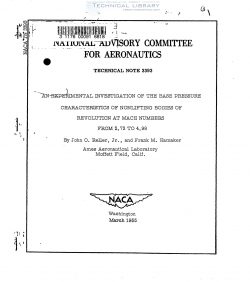naca-tn-3393
- Version
- 128 Downloads
- 1.56 MB File Size
- 1 File Count
- January 29, 2017 Create Date
- January 29, 2017 Last Updated
National Advisory Committee for Aeronautics, Technical Notes - An Experimental Investigation of the Base Pressure Characteristics of Nonlifting Bodies of Revolution at Mach Numbers

An investigation was undertaken in the Ames 10- by 14-inch super—
sonic wind tunnel to determine some of the base pressure characteristics
of related bodies of revolution at zero angle of attack. The basic body
shape used in this investigation was a lO-caliber tangent ogive nose
section combined with a cylindrical afterbody. Other related shapes
tested differed in that they had either a blunt-nosed profile or a boat-
tailed afterbody. Model fineness ratios were varied from 3.12 to 10 by
changing afterbody length. Tests were conducted at free-stream Mach
numbers from 2.73 to n.98 over a Reynolds number range, based on body
length, from 0.6 x 105 to 8.8 x 105.
In general, the base pressure coefficient decreased with increasing
Reynolds number and increased with increasing free-stream Mach number
and fineness ratio. In the particular case of an ogive-cylinder model
of fineness ratio 5 with laminar—boundaryhlayer flow at a Reynolds number
of 4 x 106, it was found that the base pressure coefficient was about
60 percent of the limiting value (represented by a vacuum) over the Mach
number range of the tests. A decrease in the base pressure coefficient,
which became more pronounced with increasing Mach number, accompanied
natural transition from laminar- to turbulent-boundary—layer flow in the
region of the base. This result is in contrast to that obtained at lower
supersonic Mach numbers where an increase in base pressure coefficient
has been found to accompany transition.
The effect on the measured base pressure of the nose-profile shapes
investigated was found to be negligible for an afterbody length of 7 body
diameters. With turbulent-boundary-layer flow over a body of fineness
ratio 7, the substitution of a 6—caliber ogival boattail (base diameter
equals 0.60h maximum diameter) for the cylindrical afterbody resulted in
an increase in the base pressure coefficient of approximately 75 percent
at a Mach number of 1.50 (as determined from tests in the Ames l— by
3-foot supersonic wind_tunnel) but only about 22 perpent at a Mach number
of h.h8:— Corresponding values for laminar flow were 36 and 28 percent,
respectively.
| File | Action |
|---|---|
| naca-tn-3393 An Experimental Investigation of the Base Pressure Characteristics of Nonlifting Bodies of Revolution at Mach Numbers.pdf | Download |

Comment On This Post